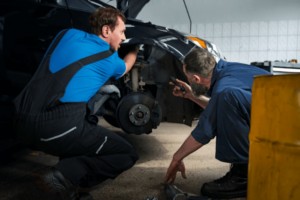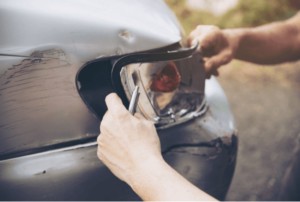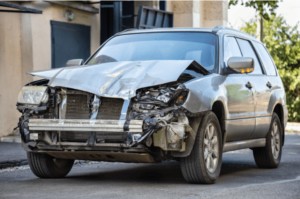Are you wondering how much a bumper repair costs after noticing damage to your vehicle? The cost of repairing a bumper can vary significantly, but HOW.EDU.VN offers expert insights to help you understand the factors influencing these costs and guide you through the best repair options. From minor scratch repairs to comprehensive bumper replacements, we ensure you make informed decisions. Considering factors like the type of damage, vehicle model, and location can greatly affect the overall expense.
1. Fixing vs. Replacing a Bumper: Which Option is Best?
Bumpers are crucial for vehicle safety, designed to absorb impact during collisions. The decision to either fix or replace a damaged bumper depends on the extent of the damage and its impact on vehicle safety.
1.1. When is Bumper Repair the Right Choice?
Bumper repair is often the preferred option for minor damage where the bumper’s structural integrity remains intact. Here are a few scenarios where repair is advisable:
- Minor Dents and Scratches: Small dents or scratches that don’t compromise the bumper’s functionality can often be repaired using techniques like paintless dent repair (PDR).
- Superficial Cracks: If the cracks are not deep and don’t affect the underlying structure, repair options like plastic filler, sanding, and repainting are viable.
- Cost-Effectiveness: For older vehicles, repairing even somewhat extensive damage might be more economical than a full replacement.
1.2. When is Bumper Replacement Necessary?
Bumper replacement is often recommended in cases of extensive damage:
- Severe Damage: Deep cracks, large dents, or holes can compromise the bumper’s structural integrity, necessitating a replacement.
- Multiple Damaged Areas: If the bumper has suffered damage in several places, a new bumper might be more cost-effective and safer.
- Age and Condition of Bumper: An older bumper that has endured previous repairs might be better off replaced.
- Technological Components Affected: Modern bumpers often house components like fog lights and sensors. If these are damaged, replacing the entire bumper assembly might be necessary.
2. Understanding the Different Types of Bumper Damage
Bumpers are prone to various types of damage due to their position on the car. Understanding these damages is essential to determine the appropriate repair method.
2.1. Common Types of Bumper Damage
- Dents: Caused by low-speed collisions or bumping into objects, these are indentations in the bumper material.
- Scratches: Result from brushes with other vehicles, walls, or vegetation, ranging from surface-level marks to deeper grooves.
- Cracks: More severe than scratches, typically resulting from harder impacts that can compromise the bumper’s structural integrity.
- Scuffs and Scrapes: Often the result of grazing another surface, leaving paint residue or superficial damage.
- Holes and Punctures: Occur from sharp or pointed impacts and can be serious, sometimes requiring a complete bumper replacement.
- Peeling Paint: Caused by exposure to elements, minor collisions, or poor paint jobs.
2.2. Identifying the Severity of Damage
Determining the severity of the damage helps in deciding whether to repair or replace the bumper. Minor scratches and dents may only need cosmetic repairs, while significant cracks and holes may necessitate a full replacement to ensure vehicle safety. Consulting with experts at HOW.EDU.VN can provide a detailed assessment of the damage and the best course of action.
3. What is the Average Cost for Car Bumper Repair?
On average, repairing a car bumper can cost anywhere from $150 to $600. However, several factors influence this cost, including the type of damage, the car’s make and model, and the repair shop’s labor rates.
3.1. Average Costs for Different Types of Bumper Damage
| Type of Damage | Repair Needed | Average Cost |
|---|---|---|
| Minor Dent | Dent Removal | $150 – $250 |
| Scratch | Paint Touch-Up | $100 – $300 |
| Crack | Plastic Welding/Reshaping | $250 – $500 |
| Major Dent | Panel Beating/Repainting | $350 – $600 |



3.2. Factors Influencing Bumper Repair Costs
Beyond the type of damage, several other factors can influence the cost of bumper repairs:
- Car Make and Model: Luxury or foreign cars may require specific parts or custom paint that are more expensive and harder to source.
- Labor Rates: Rates vary by location and shop type. Specialized shops or urban areas often charge more.
- Geographic Location: Costs for materials and labor can vary by region. Remote locations may incur extra shipping fees for parts.
- Material and Part Availability: Some bumper materials, especially for newer or luxury models, can be rare and costly to obtain.
Understanding these factors can help you better anticipate the costs and plan accordingly. Experts at HOW.EDU.VN can provide tailored advice based on your specific situation.
4. What is the Average Cost for Car Bumper Replacement?
Sometimes, replacement is more feasible than repair. The cost for bumper replacement ranges between $500 to $1,500, varying with car types and models.
4.1. Average Bumper Replacement Costs by Car Type
| Car Type | Average Replacement Cost |
|---|---|
| Economy Car | $500 – $700 |
| Mid-Range Car | $700 – $1,000 |
| Luxury Car | $1,000 – $1,500 |
4.2. Factors Increasing Bumper Replacement Costs
Several factors can drive up the cost of a bumper replacement:
- Type of Vehicle: Luxury and high-performance vehicles typically have more expensive parts.
- Bumper Material: The material of the bumper (e.g., plastic, fiberglass, carbon fiber) affects the cost.
- Integrated Technology: Bumpers with integrated sensors or cameras require recalibration, adding to the labor costs.
- Paint and Finish: Matching the exact paint color and finish of the vehicle can also increase costs.
5. How to Determine the Kind of Bumper Repair Needed
Determining the right repair approach for your car bumper can be challenging. Whether it’s a minor scratch on your front bumper or extensive damage to your rear bumper, a systematic approach can help you assess the damage and decide on the best course of action.
5.1. Steps to Assess Bumper Damage
- Inspect the Damage: Carefully examine the bumper for dents, scratches, cracks, or any other visible damage.
- Assess the Severity: Small dents and light scratches might only need minor repairs like paintless dent repair, while large cracks or holes may require more extensive work or even a bumper replacement.
- Check for Hidden Damage: If the bumper feels loose or there’s damage to the car’s body near the bumper, it might indicate deeper issues.
- Consider Safety and Functionality: If the damage might affect the vehicle’s safety, such as interfering with sensors or lights, professional assessment at an auto body shop is necessary.
- Professional Assessment: For complex or severe damage, or if you’re unsure, consult with a reputable repair shop.
5.2. The Role of Professional Assessment
Professional assessment from an auto body shop is crucial for complex or severe damage. Technicians can provide a detailed evaluation using specialized tools and advise on whether a simple repair or a new bumper is needed.
6. How Insurance Impacts Bumper Repair Decisions
When considering whether to file an insurance claim for bumper repair or replacement, it’s crucial to understand the potential impact on your insurance premiums.
6.1. Factors to Consider Before Filing a Claim
- Cost of Repair vs. Deductible: Compare the bumper repair cost to your deductible. If the repair cost is close to or less than your deductible, paying out of pocket might be more cost-effective.
- Nature of the Accident: If you were at fault, filing a claim could lead to an increase in your car insurance premiums.
- Frequency of Claims: Filing multiple claims, even for minor damage, can lead to higher premiums.
- Policy Terms: Understand your insurance coverage, including aspects like collision repair coverage and whether you have accident forgiveness.
- Long-Term Cost Consideration: Weigh the long-term cost of increased premiums against the immediate bumper replacement cost or repair expenses.
- Claim History and Loyalty: A long, claim-free history with your insurance company might influence their decision on premium adjustments.
6.2. Understanding Your Insurance Policy
Understanding your insurance policy is key to making informed decisions about filing a claim. Knowing the details of your coverage, deductible, and potential impact on premiums can save you money in the long run.
7. DIY vs. Professional Bumper Repair
Deciding whether to tackle bumper repair yourself or hire a professional is a common dilemma. Each approach has its own set of advantages and disadvantages.
7.1. Advantages and Disadvantages of DIY Bumper Repair
Advantages:
- Cost Savings: DIY repairs can save money on labor costs.
- Convenience: You can perform the repairs at your own pace and convenience.
- Learning Experience: It can be a valuable learning experience for those interested in auto mechanics.
Disadvantages:
- Quality Concerns: DIY repairs may not match the quality of professional work.
- Time Commitment: Repairs can be time-consuming, especially without experience.
- Potential for Further Damage: Incorrect techniques can worsen the damage.
7.2. When to Choose Professional Bumper Repair
Professional bumper repair is the better choice when:
- The Damage is Extensive: Significant cracks, dents, or structural damage require professional expertise.
- You Lack Experience: If you’re not confident in your repair abilities, hiring a professional is safer.
- Specialized Tools are Needed: Some repairs require specialized tools and equipment that are not readily available.
- Ensuring a Quality Finish: Professionals can ensure a high-quality finish that matches the original appearance of the vehicle.
8. Choosing the Right Repair Shop: What to Look For
Selecting the right repair shop is essential for ensuring quality bumper repairs. Consider the following factors when making your choice:
8.1. Key Factors to Consider
- Reputation: Look for shops with positive reviews and testimonials.
- Certifications: Check for certifications such as ASE (Automotive Service Excellence).
- Experience: Choose a shop with experienced technicians specializing in bumper repairs.
- Warranty: Ensure the shop offers a warranty on their repairs.
- Estimates: Obtain detailed estimates before committing to the repairs.
- Customer Service: Evaluate the shop’s customer service and responsiveness.
8.2. Questions to Ask Before Hiring a Repair Shop
- Are you certified and insured?
- Do you offer a warranty on your repairs?
- Can I see examples of your previous work?
- How long will the repair take?
- What is the total estimated cost, and are there any potential hidden fees?
- Do you use genuine parts?
- Will you match the paint color accurately?
9. The Impact of Bumper Material on Repair Costs
The material of your car’s bumper significantly affects repair costs. Different materials require different repair techniques and have varying price points for parts and labor.
9.1. Common Bumper Materials and Their Repair Costs
- Plastic: Common in modern vehicles, plastic bumpers are relatively inexpensive to repair for minor damages. However, extensive cracks may require replacement.
- Fiberglass: Often found in older cars, fiberglass bumpers can be challenging to repair due to their brittle nature. Repairs may be more labor-intensive and costly.
- Steel: While durable, steel bumpers are prone to rust and dents. Repairing steel bumpers involves metalwork, which can be expensive.
- Aluminum: Lightweight and corrosion-resistant, aluminum bumpers are more common in luxury vehicles. Repairs require specialized techniques and can be costly.
- Carbon Fiber: Found in high-end sports cars, carbon fiber bumpers are expensive to repair due to the specialized materials and expertise required.
9.2. Matching Paint Colors and Finishes
Matching the exact paint color and finish of the vehicle is crucial for a seamless repair. This process involves:
- Color Matching: Using specialized tools to analyze the existing paint and create a perfect match.
- Blending: Blending the new paint with the surrounding areas to ensure a smooth transition.
- Clear Coat: Applying a clear coat to protect the paint and provide a glossy finish.
10. What are the Latest Trends in Bumper Repair Technology?
The automotive repair industry is continuously evolving, with new technologies and techniques emerging to improve the efficiency and effectiveness of bumper repairs.
10.1. Advanced Techniques in Bumper Repair
- Paintless Dent Repair (PDR): A technique used to remove minor dents without affecting the paint finish.
- Plastic Welding: Used to repair cracks and splits in plastic bumpers, restoring their structural integrity.
- Computerized Color Matching: Utilizes advanced software to precisely match the paint color, ensuring a seamless finish.
- 3D Printing: Emerging as a potential solution for creating custom bumper parts and components.
10.2. Eco-Friendly Repair Options
With increasing environmental awareness, eco-friendly repair options are gaining popularity:
- Water-Based Paints: These paints have lower VOC (volatile organic compound) emissions, reducing their environmental impact.
- Recycled Parts: Using recycled bumper parts helps reduce waste and conserve resources.
- Energy-Efficient Equipment: Repair shops are adopting energy-efficient equipment to minimize their carbon footprint.
11. Frequently Asked Questions (FAQs) About Bumper Repair
Q1: How do I know if my bumper needs repair or replacement?
Inspect the bumper for dents, scratches, cracks, or holes. Minor damages can be repaired, while extensive damage may require replacement.
Q2: Can I repair a cracked bumper myself?
Minor cracks can be repaired with DIY kits, but significant cracks should be repaired by a professional to ensure structural integrity.
Q3: How long does a bumper repair take?
The duration depends on the extent of the damage. Minor repairs can take a few hours, while more extensive repairs may take a day or two.
Q4: Will a bumper repair affect my car’s resale value?
A professionally done repair should not significantly affect resale value. However, poor-quality repairs may lower the value.
Q5: How can I prevent bumper damage?
Practice safe driving habits, avoid tailgating, and be cautious when parking in tight spaces.
Q6: What is the difference between a front bumper and a rear bumper?
Front bumpers are designed to protect the front of the vehicle, while rear bumpers protect the rear. Both serve the same purpose of absorbing impact during collisions.
Q7: Do all cars have the same type of bumper?
No, bumpers vary in material and design based on the make, model, and year of the vehicle.
Q8: Can I claim insurance for bumper repair?
Yes, you can claim insurance, but consider the cost of repair versus your deductible and potential impact on premiums.
Q9: What certifications should I look for in a repair shop?
Look for certifications such as ASE (Automotive Service Excellence).
Q10: How do I get an accurate estimate for bumper repair?
Visit a reputable repair shop and request a detailed estimate that includes parts, labor, and any additional fees.
12. Expert Advice from HOW.EDU.VN’s Network of PhDs
At HOW.EDU.VN, we connect you with a network of over 100 PhDs and experts who can provide specialized advice on automotive repairs. Our experts have extensive knowledge in material science, automotive engineering, and collision repair.
12.1. Benefits of Consulting Our Experts
- In-Depth Analysis: Our experts can provide a thorough analysis of the damage and recommend the best repair solutions.
- Cost-Effective Solutions: They can help you identify cost-effective repair options without compromising quality or safety.
- Cutting-Edge Insights: Stay informed about the latest trends and technologies in bumper repair.
- Personalized Advice: Receive tailored advice based on your specific vehicle and situation.
12.2. How to Connect with Our Experts
- Visit HOW.EDU.VN.
- Submit your query or request for consultation.
- Get connected with a relevant expert.
- Receive personalized advice and solutions.
13. Conclusion
Dealing with bumper damage can be stressful, but understanding the costs involved and the available repair options can empower you to make informed decisions. Whether you need a minor dent repair or a complete bumper replacement, HOW.EDU.VN is here to guide you through the process.
13.1. Final Thoughts on Bumper Repair Costs
The cost of bumper repair varies based on the type of damage, vehicle model, material, and location. By understanding these factors, you can better prepare for the expenses and ensure a smooth repair process.
13.2. Take the Next Step with HOW.EDU.VN
Don’t let bumper damage keep you off the road. Contact HOW.EDU.VN today for expert advice and solutions.
Are you facing difficulties in assessing your bumper damage or confused about the best repair options? Do you want to ensure you’re getting the most cost-effective and reliable solution?
At HOW.EDU.VN, we understand the challenges of dealing with vehicle repairs. Our team of over 100 PhDs and experts is dedicated to providing you with personalized, in-depth consultations to address all your concerns. We offer:
- Expert Analysis: Connect directly with PhDs who specialize in automotive engineering and material science.
- Cost-Effective Solutions: Receive advice tailored to your budget and specific needs.
- Reliable Guidance: Ensure your repairs are done right the first time with our expert recommendations.
Don’t waste time and money on guesswork. Contact our experts today and get the peace of mind you deserve.
Address: 456 Expertise Plaza, Consult City, CA 90210, United States
WhatsApp: +1 (310) 555-1212
Website: HOW.EDU.VN
Let how.edu.vn be your trusted partner in navigating the complexities of bumper repair. Connect with us today and experience the difference expert guidance can make. We provide top-notch automotive solutions, expert consultations, and reliable repair advice.